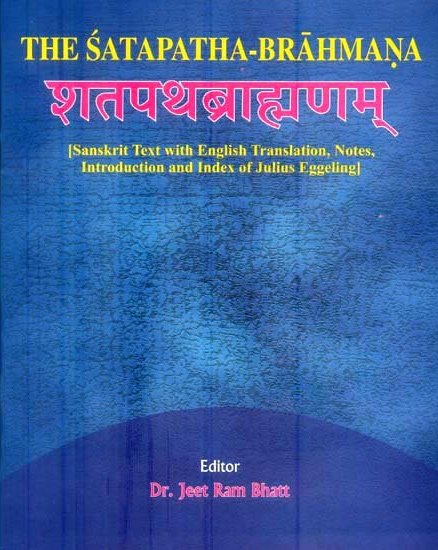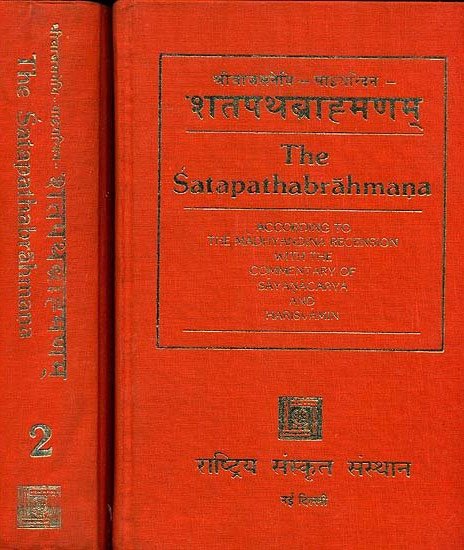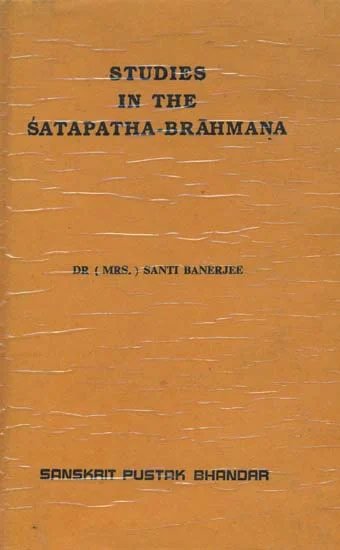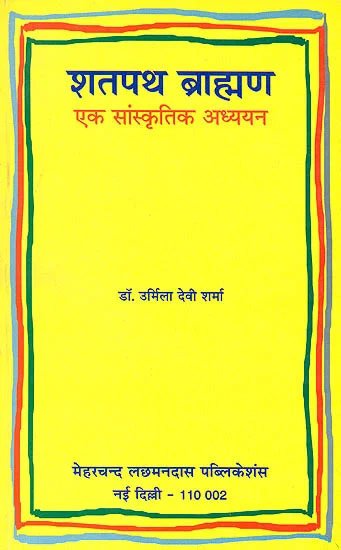Satapatha-brahmana [sanskrit]
147,532 words | ISBN-10: 812080113X | ISBN-13: 9788120801134
The Sanskrit text of the Satapatha-brahmana: One of the largest works in the category of Vedic (Brahmaic) literature, narrating in extensive detail the various rites, constructions, chants and utensils to be used in Hindu ceremonies. Alternative titles: Śatapathabrāhmaṇa (शतपथब्राह्मण), Śatapatha-brāhmaṇa (शतपथ-ब्राह्मण) Shatapathabrahma (shatapatha).
Verse 4.5.2.10
yasyai te yajñiyo garbha iti | ayajñiyā vai garbhāstametadbrahmaṇaiva yajuṣā yajñiyaṃ karoti yasyai yonihiraṇyayītyado vā etasyai yoniṃ vicindanti yadado niṣkarṣantyamṛtamāyurhiraṇyaṃ tāmevāsyā etadamṛtāṃ yoniṃ karotyaṅgānyahrutā yasya tam mātrā samajīgamaṃ svāheti yadi pumāntsyādyadyu strī syādaṅgānyahrutā yasyai tām mātrā samajīgamaṃ svāheti yadyu avijñāto garbho bhavati puṃskṛtyaiva juhuyātpumāṃso hi garbhā aṅgānyahrutā yasya tam mātrā samajīgamaṃ svāhetyado vā etam mātrā viṣvañcaṃ kurvanti yadado niṣkarṣanti tametadbrahmaṇaiva yajuṣā samardhya madhyato yajñasya punarmātrā saṅgamayati
Preview of English translation:
10. With (Vajasaneyi Samhita VIII, 29), “Thou whose fruit is fit for sacrifice,”—for embryos are unfit for sacrifice: this one he thus makes fit for sacrifice by means of the Brahman, the Yajus;—“thou who hast a golden womb,”—for on that former occasion, they rend the womb when they tear out (the embryo); and gold means immortal life; he thus makes that womb of her (the cow) immortal;—“Him whose limbs are unbroken, I have brought together with his mother, Hail!” Thus, if it be a male (embryo); but if it be a female one, with, “Her whose limbs are unbroken, I have brought together with her mother, Hail!” And, if it be an indistinguishable embryo, let him offer in making it male, since embryos (garbha, masc.) are male, “Him whose limbs are unbroken, I have brought together with his mother, Hail!” For on that former occasion, when they tear out (the embryo) they separate it from its mother: now, having rendered it successful by means of the Brahman, the Yajus, he brings it again together with its mother in the midst of the sacrifice.
For a detailled translation, including proper diacritics and footnotes, go the full English translation.
Other editions:
Also see the following editions of the Sanskrit text or (alternative) English translations of the Satapatha-brahmana Verse 4.5.2.10
The Satapatha Brahmana (In Five Volumes)
by Julius Eggeling (1882)
2551 pages; [Publisher: Motilal Banarsidass Publishers Pvt. Ltd.]
Buy now!
The Satapatha Brahmana (3 volumes)
by Dr Jeet Ram Bhatt (2009)
Sanskrit Text with English Translation; 1726 pages; [Publisher: Eastern Book Linkers]; ISBN: 9788178541693
Buy now!
The Satapatha Brahmana (With The Commentary of Sayanacarya and Harisvamin)
by Rashtriya Sanskrit Sansthan (2002)
3483 pages; [शतपथ ब्राह्मणम्] According to the Madhyandina Recension; Commetaries: (1) Vedarthaprakash (Vedartha-prakasha) by Shrimat-Trayibhashyakar Sayanacharya, (2) Sarvavidyanidhana Kavindracharya Saraswati.
Buy now!
Studies in the Satapatha-Brahmana
by Dr. (Mrs.) Santi Banerjee (1993)
236 pages; [Publisher: Sanskrit Pustak Bhandar]
Buy now!
Cultural Study of the Satapatha Brahman (in Hindi)
by Dr. Urmila Devi Sharma (1982)
106 pages; Shatapatha Brahmana Ek Sanskritik Adhyan; [Publisher: Meharchand Lakshmandas Publications]
Buy now!![Satapatha-brahmana [sanskrit] - book cover](/uploads/a/NAC457-Satapatha-Brahmana.jpg)



